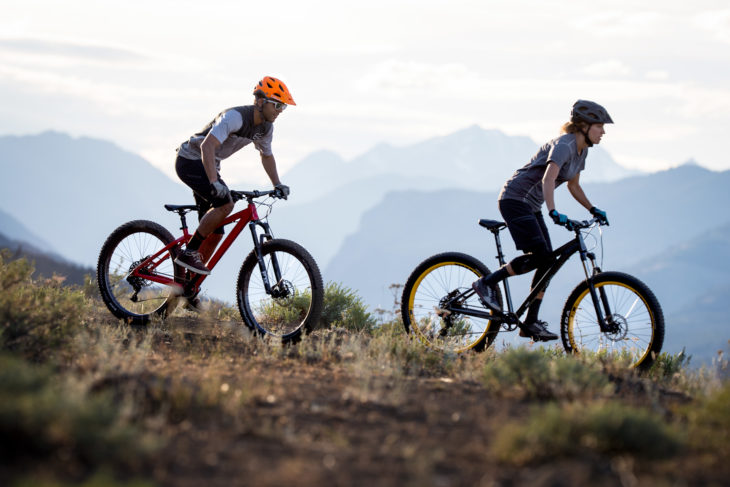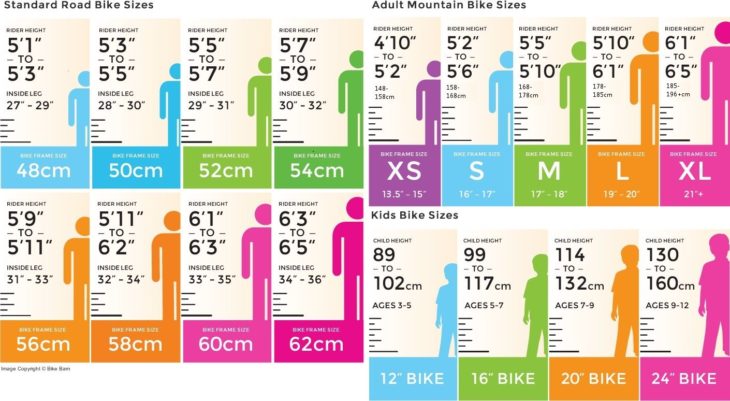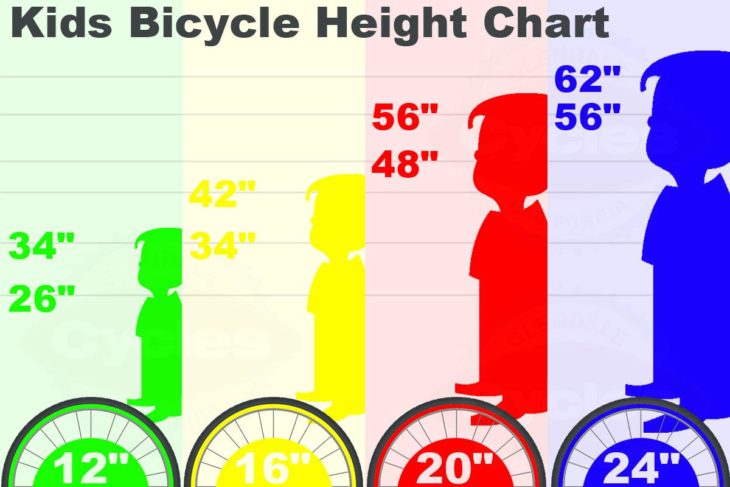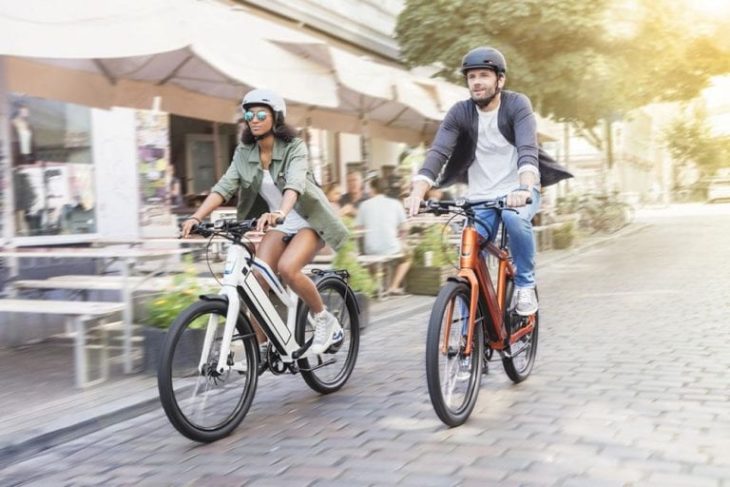Like clothing, a bicycle must fit our body size to be comfortable, convenient, and safe. In terms of height, you don’t really have to touch or get on a bike to buy it – I’ll help you make the right choice.
As a rule, every model is available with different frame sizes. This is done in order to make riding as comfortable and safe as possible for a person of a certain height. Let’s make sure of that.
According to the bikesbros.com, frames of different sizes differ in length of almost all the tubes/pipes. Long ago, the distance from a bottom bracket to the end of a seat pipe was taken as a standard measure for frame size. It’s mainly expressed in inches and sometimes in centimeters (1″ = 2.54 cm). For a long time, this value perfectly described the size of a bike’s frame while its geometry remained unchanged – a classic double triangle of straight pipes. With the advent of hydroforming technology, it became possible to make frames from bent pipes, and the place where the upper pipe joins the seat pipe became more variable, along with its “outlet” length above the upper pipe, “overestimating” the frame height but not changing its geometry. Thus, the size of the frame in inches has become less and less realistic to match the height of a cyclist for which this frame is produced, so the overwhelming majority of manufacturers have switched to the literal designation of frame growth. And it became easier. You know that “M” is the right frame for your height, and that’s all you need to know.
However, there is still confusion, because some manufacturers are still “sitting” on outdated inches of a seat pipe. Someone measures it in centimeters, and some manufacturers use letters, but the boundaries of human height for each letter may vary from model to model. However, these differences are insignificant. In order not to burden you with theory, I will go over to the bike’s height selection algorithm.

Source: Ride Diamondback Bicycles
Choosing a bike by height
1. Measure your real height (without shoes) by the wall. There have been cases when people would be inaccurate (up to 4″ difference), telling their heights.
2. First, we turn to the manufacturer’s dimensional grids, according to a specific model.
3. If there is no such grid, we select the size of a standard (universal) grid which is given in the chart below.
4. Before deciding on the size of your bike, consider the following factors:
a) If your height falls within the size limit, it is better to choose a smaller size for regular riding and a larger size for speed/sports riding.
b) When choosing the size of a 29er frame, consider choosing a bike smaller than 26″-27.5″.
c) All other things being equal, smaller bikes are more maneuverable and weigh 0.3-0.4 lbs less than the next bigger size.
d) Large (L, XL, XXL) frames have thicker pipe walls as they are designed for a higher weight.
e) If you have a large (extra) weight, then the compensation for the strength of the bike is done by choosing another model (increased strength), not bigger frame size.
f) Riding a too-big bike poses a risk of poor control and hitting the crotch on the frame top when jumping off the bike.

Source: Cycling Today
You will also have additional options to adjust your own positioning. I emphasize that it is not necessary to do it, but you have the opportunity. If you need a more inclined position, you can lower the handlebar by shifting lock rings under the stem to the top of the handlebar. Despite the seeming insignificance, you will clearly feel that your position has become more horizontal and aerodynamic, hand pressure will increase. Changing the stem has a strong effect on positioning and handling. The length of the stem can be from 1.57″ to 4.72″. The shorter the stem, the more responsive the bike is to handlebar movements, the easier it is to take off the front wheel off the ground, the shorter and more straight-up is your position – all this is important if you prefer speed to technical riding.
If you’re more interested in speed at straight-line segments, a longer stem will give you smoother control and a “longer” riding position. Increasing the tilt angle of a handlebar is tantamount to raising/lowering it and also affects your position. Sometimes, to significantly lower a handlebar, the stem can be overturned, but not all handlebars allow it. Check the documentation and stickers on the stem, as it can be dangerous to drive with a stem turned upside down. The saddle can also be moved 0.4-0.8″ back and forth to fine-tune your riding position.
Typical mistakes
Some people rely on their own decisions about a proper bike size and sometimes they are wrong. What can this lead to?
A one-size-fits-all frame. “I want a bike that fits both my 72.8″ and my wife’s 63″ height.” This desire to save money is justified, but size “L” or “XL” is right for a man and size “S” or “M” for a woman. If you choose a “unisex” size, it will be uncomfortable for both of you to ride, and even dangerous for a smaller one. In this case, everyone needs their own bike.

Source: Bikelah
A kids bicycle with room to grow
A lot of people want to buy their child a bike for ages to come but here it’s best to stick to recommendations as well. The fact is that a child riding a too-big bike can get injured by hitting the crotch on a high frame. Fidgeting on the saddle may also be the case – when a kid can’t pedal normally (since the feet simply do not touch the pedals), it’s fraught with falling of the bike. In addition, children’s bicycles are equipped with different sizes of brake handles, depending on their age. In this case, your child’s hand may be too small to brake, and this is very dangerous.
“No suitable height – no problem, I’ll take a smaller one…” In this case, you will have to push the seatpost quite far out of the frame above the maximum allowable level. This is strictly prohibited because you can not only irreversibly damage the frame, but also cause a serious injury if the seatpost pops out while riding. Sometimes, buying a longer seatpost may “save” in such case, but if you have a weight of more than 176 lbs when equipped for riding, I do not recommend doing so. You’d better get a bike that fits your height.

Source Spropellerbikes.co.uk
A STANDARD TABLE OF BIKE SIZE AND HEIGHT
Height – Size – Mountain – Tourist/city
55.11-61.02 – XS – 13 – 14
59.05-64.96 – S – 15 – 16
63-68.89 – M – 17 – 18
66.92-72.83 – L – 19 – 20
70.86-76.77 – XL – 21 – 22
74.8- … – XXL – 23 – 24
Recommendations
1. Choosing a frame size is not that definitive – a mistake (by one value) is not critical and can be corrected without interfering the design of a bike. If the bike seems a little small to you, you can lift the seat up and push it back a little. You can also tilt the handlebar or change the stem to a higher and longer one. Conversely, if you think your bike is too big.
2. Consider your riding style. Choose a smaller frame if you prefer slower rides in the park (more upright and less tense back), choosing a bike for the elderly, ride an aggressive style with more jumps (a low frame will make it easier to jump and reduce the chance of hitting it if you fall). In any case, be sure to clear your choice with a professional to be sure it’s right.
You can also find a large choice of pre-owned bikes along with great pro advice on cyclingavenue.com.
